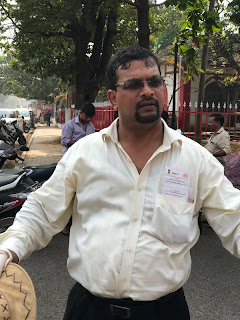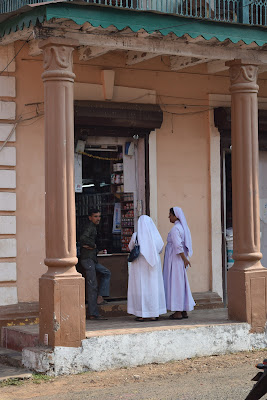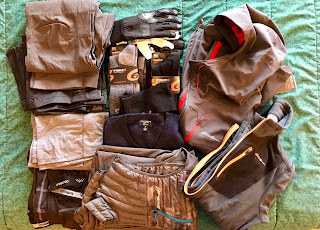2018 "Song of India" Adventure - Day 14 - Goa, India
Day 14
– Monday, March 5th – Goa, India
(Steve writing) When we awoke and pulled
back the curtain, all we could see was sea and smog. There was no land to be
seen until the ship got closer to the jetty/pier. This time we weren’t at a
cargo terminal, which was a welcome change. Through the haze, we could see a
nearby hill with an outline of palm trees and a building or two, but there wasn’t
much to offer in the way of vistas.
Today was the
second of the two tours booked through Muziris
Heritage Day Tours, since
they offered a good package ($170 each for two full days). We had a good
experience in Cochin, and were looking forward to today’s outing.
We left the ship
at 8:30, and on the dock were friendly Indian immigration officers who gave our
landing cards another stamp. No passports, no extra paperwork. Nice and easy
and relaxed. We met up with our guide, Jack, who escorted us to our mini-bus
with the other four passengers: a couple from Darwin, Australia (Merv and Sue),
and a couple from Luton, England (Louis and Sandra). Under the care of our
driver, Raju, we quickly left the port area and headed inland.
 |
| Our guide Jack |
But 450 years of
Portuguese occupancy made its mark on this area. In every town and village, you
saw colonial-era buildings and Catholic churches. Lots of churches. (At some
point later in the day, I said that you couldn’t swing a dead cat without
hitting a church. Just like Rome.)
Goa is lush and
tropical, and famous for its beaches. Many Indians vacation here, as well as
visitors from Europe and Russia. The traffic wasn’t as crazy as in Cochin,
although the scooters and motorcycles still outnumber the cars. There was also
a fair amount of road construction: new bridges and wider highways. Given the
volume of vehicles, these appear to be smart investments.
Our first stop
was in the Latin Quarter of the capital city of Panaji, also known as
“Fontainhas”. As I said earlier, there are wonderful examples of the Portuguese
colonial style architecture along its winding, narrow streets.
Our group walked
through the area, enjoying the bright colors and occasional bursts of flowers
from some of the smaller gardens. But noisy scooters marred what would
otherwise be a peaceful and quiet area.
The next stop
was at the various markets in Panaji. First was a fish market, where Jack
picked up a very small crab that had the symbol of a cross on its back. There
were large quantities of prawn, mackerel, and other fish. It wasn’t as stinky
as other fish markets I’ve been through, but all in all, I was glad to get out
of there.
We walked
another block toward the produce and flower market. Stalls were overflowing
with vegetables of all shapes, sizes, and colors, sold by very vocal salesmen. There were also a fair
number of women who were doing the selling. Jack told us that while the men are
in the fields or fishing, the women are doing the selling. In this cornucopia
of vegetables, we even saw a poster for Washington State apples!
We were given
about twenty minutes to explore an adjacent market that had non-food items.
Again, stall after stall of shoes, electronic goods, toys, etc. Just as in
Colombo. And with salesman just as eager to strike a bargain (surprisingly,
neither Allan nor I bought anything).
 |
| He actually had a sweet smile...after I took the photo! |
Before we left Panaji,
we walked for a bit on the promenade along the Mandovi River. Anchored offshore
(but fairly close) were a number of floating casinos. There were a couple that
looked like large American paddle wheelers (think the Mississippi River) and
this one that looked like a large fish:
 |
| Like something out of a Tim Burton movie... |
Back on the bus,
we headed out of town along crowded two-lane highways. As with Cochin, drivers
played “chicken” here, and the two marked lanes became three or four, depending
on who was trying to get around who. The scooters usually lost and were stuck
in the left-most part of the road. Once again, I felt our driver deserved a
medal of bravery.
There was a
brief stop at a fancy souvenir store with overly eager salesmen (sounds like a
theme, doesn’t it?) and better yet, clean bathrooms. Given the state of public
toilets in India, when you can find a clean, well-equipped one, you use it.
Sorry, dear reader: I’ve never been a fan of the squat-over-a-hole-in-the-floor
style of commode. If that makes me a spoiled Western traveler, so be it. (hear hear! – AFK)
Jack was keen to
point out various churches in the area. As I wrote earlier, there were a lot of
them. But the motherlode was the next stop: Basilica of Bom
Jesus. It was a Baroque
cathedral completed in 1605. Designated by UNESCO as a World Heritage site, it
holds the mortal remains of St. Francis Xavier. The church was located in a
beautiful park-like setting, with the Church of St. Francis Assisi situated on
the other side of that park.
 |
| Basilica of Bom Jesus - Interior |
 |
| Basilica of Bom Jesus - Exterior |
 |
| Church of St. Francis Assisi on the right |
One thing that
we noticed while traveling in this country is that the young Indians love to
take selfies. Everywhere. Guys seem to take photos of each other, posed as if
to be placed in an online ad. The church had the typical warning sign of “No
flash photography”, “No tripods”, and appropriately enough, “No selfies”. Sure
enough, there was a group of young men taking a group selfie in front of the silver
casket where the remains of St. Francis Xavier are laid to rest. A church guide
chided them saying “No selfies here. Do them at home. This is a religious
place!”
To keep things
even-Steven, as it were, we next went to visit the Mangeshi Hindu Temple. We
were let off about 200 meters from the temple, and walked along a road with
vendors on both sides. Some were selling beautiful arrangements of flowers to
take into the temple, some sold pretty dresses for girls, and most were selling
food and drink. This being India, there were also cows roaming here and there:
 |
| Just hanging around the school gate |
The temple itself
was on higher ground, in a compound of other buildings, all painted in bright
colors. There were crowds of people, mostly family groups. Many of the older
women wore brightly-colored saris which caught the sunlight and shimmered. I
have been reluctant to take photos of these women because I didn’t want to
invade their privacy. But they do show up in photos, so keep an eye out.
We removed our
shoes and went into the temple. Despite how large it looked on the outside, it
was rather small on the inside. There wasn’t anywhere near as much color, but
there was a lot of silver wall decoration and small, chandelier-like lighting
fixtures. And the smell of incense. But no interior photos allowed. After the
comparative grandeur of Bom Jesus, this seemed a bit of a letdown. But the tour
group, when offered the option to see this temple, was eager to see it.
(By now it was brutally hot and humid.
Sweat was pouring out of me as if I were a natural spring, and my energy level
was fading quickly… - AFK)
 |
| Mangeshi Temple - Compound |
 |
| Mangeshi Temple |
It was early
afternoon, and we’d been going since 8:30. Allan was starting to have low-blood
sugar, and asked Jack to get him some fruit juice. The high temperature and
humidity have forced us to be constantly drinking bottled water, and just as
constantly sweating it out. But the blood-sugar crash was a little scary. (Lesson learned: bring snacks. Always bring
snacks. ALWAYS bring SNACKS! – AFK)
The final stop
on our excursion would be lunch and a tour of a spice plantation. When we arrived
at the Tropical Spice Plantation, we were shocked to see about a dozen
large buses from the ship’s sanctioned tours! So much for intimate,
off-the-beaten path adventures. We ran into Michael and Bobby who were on one
of those tours. (I think there were
closer to twenty vans and busses parked in the lot, but surprisingly there
weren’t more than a couple hundred people in the dining hut area when we
arrived. They must have all been on their post-lunch spice walk. – AFK)
It was located
in a beautifully lush setting along a lake. There were some egrets among the
reeds, as well as cormorants. The lunch was served under a large shed
structure, and we arrived just as the other tour groups were finishing up.
Lunch consisted of rice, daal (spiced lentils), chicken curry, fish stew, papadams
(spicy crackers), and watermelon slices served on a banana leaf. The quality
was okay, with the standout being the papadams. Cold beverages were also
provided (Allan and I had Limca, which is a Coca Cola product sort of like
Sprite).
The spice tour
was given by a charming young woman, and done as a walk-through along a path
among the tall trees and bushes. There were beautiful flowers, which makes
sense, since many of those flowers are orchids that are attached to the spice
fruit. We also saw cashew trees, where the cashew pod hangs below a fruit that
looks like a small bell pepper and is often mashed and made into alcohol (we
were told this more than once). The cashew pod has to be opened using gloves,
because the skin surrounding the nut can burn your skin. This, dear readers, is
why cashews are more expensive than peanuts.
(I think I enjoyed the spice walk a lot
more than Steve did. Even though I spent most of that time taking photos of the
various flowers and plants with my macro lens, I did listen and learned quite a
lot. It was fascinating to see where/how a lot of our various, and most popular
spices (black pepper, clove, cinnamon, saffron, and allspice) are grown and
what they look like in their natural form. This was definitely one of the major
highlights of the trip for me. Brilliant! – AFK)
 |
| Our path through the tropical spice plantation |
 |
| Black pepper - the king of spice! |
 |
| Bird of Paradise |
As we left the
plantation to head back to the ship, we saw two oxen standing at the far side
of the lake, with birds on their backs. Ah, nature!
 |
| The water oxen on the lake...with hitchhikers |
We arrived at
the pier around 4:27PM, hurriedly showed our landing cards to the Indian
immigration officers, and scurried up the gangplank. Louis was the last one to
board, just at the 4:30PM cut-off time. Whew! (Surprisingly, I was not really concerned about being late. I just
knew, somehow, we would make it, and we did. ;-) – AFK)
Café al Bacio
was our first destination for some cold drinks (their ginger pear iced tea is
heavenly). The drinks arrived just as the ship was leaving the pier and backing
out into the harbor (modern cruise ships are so maneuverable, without the aid
of tugboats). After a longish nap, we had dinner in Blu. Surprisingly, we were
seated at the same back corner table we had for breakfast. Dinner was relaxed
and enjoyable, and after a turn about the promenade deck, we settled into bed.
Tomorrow:
Mumbai, financial powerhouse of India and home to Bollywood!





Comments